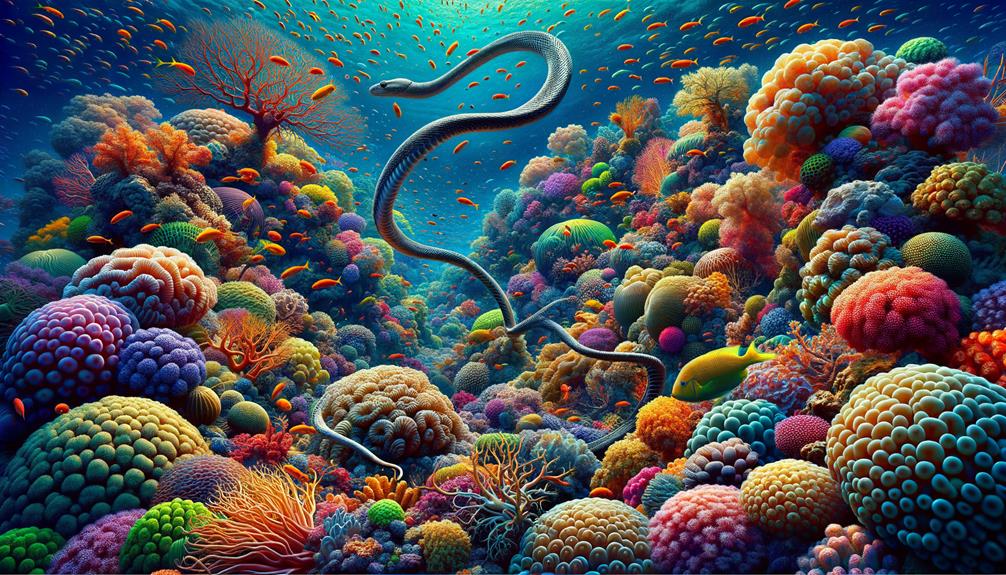The Orinoco River snakes through South America's heart, serving as a vital habitat for the distinctive Orinoco Crocodile. These reptiles, with their slim snouts and eye-catching skin patterns, do more than catch our attention—they're key indicators of the river's health. Their knack for adapting is impressive; they carve out homes along the banks, making the most of the diverse terrain. But these crocs face serious risks, and understanding their unique traits and challenges is crucial. Conservation efforts are underway, but questions remain about their effectiveness and what more can be done to protect these remarkable creatures. The Orinoco Crocodile's story is one of survival against the odds, highlighting the broader issues of habitat loss and human impact on wildlife. As we consider their plight, it's worth asking: What steps are being taken to ensure these ancient reptiles continue to thrive in their South American stronghold?
Taxonomy
The Orinoco crocodile, scientifically known as Crocodylus intermedius, stands out among the Crocodylidae family. These impressive reptiles call the Orinoco river basin home, spanning across Venezuela and Colombia. Their unique place in the ecosystem showcases their ability to thrive in specific environments.
As part of the Crocodylinae subfamily, C. intermedius sets itself apart from its cousins like C. acutus, C. halli, and C. suchus. One of its standout features is a long, narrow snout – a key adaptation for survival and hunting in its native habitat.
The Orinoco river basin's varied landscape has played a significant role in shaping these crocodiles over time. Their presence in both Venezuela and Colombia speaks to their adaptability and the vital role they play in local ecosystems. Studying C. intermedius offers insights into not just its scientific significance, but also its integral part in the intricate web of wildlife in the region.
Understanding these crocodiles goes beyond mere classification. It opens a window into the complex relationships within their environment, highlighting the diversity and resilience of life along the Orinoco. This knowledge serves as a reminder of the rich tapestry of nature and the importance of preserving such unique species and their habitats.
Physical Characteristics
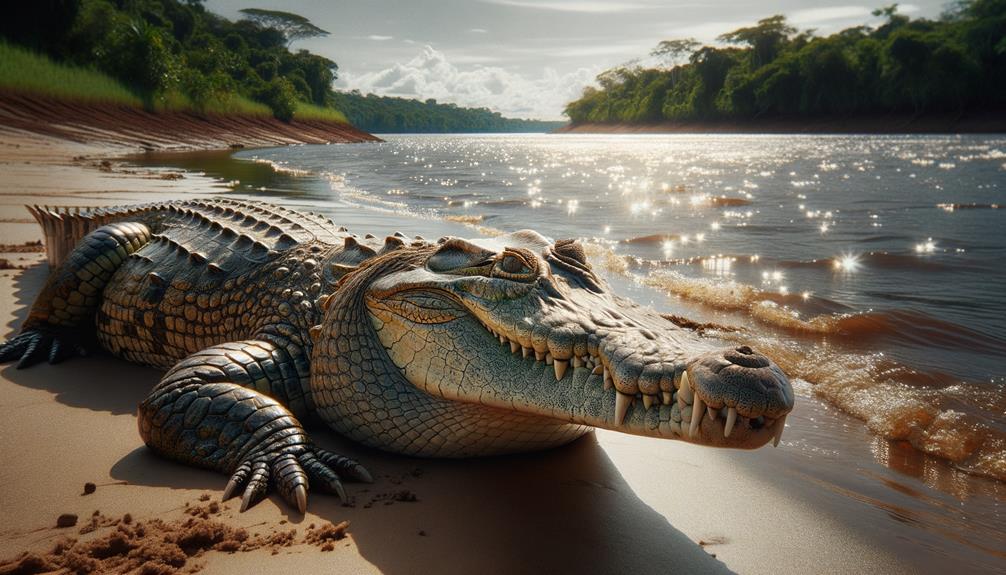
Orinoco crocodiles are massive creatures that catch the eye with their unique features. Their long, narrow snouts house 68 razor-sharp teeth, making them formidable predators. These reptiles can tip the scales at over 400 kg and stretch up to 6.7 meters, putting them among the largest crocodile species worldwide. Their light-colored bodies with dark-brown patterns set them apart from their darker cousins.
Young Orinoco crocodiles sport eye-catching dark bands on their bodies and tails. As they grow older, these markings fade, but they leave a lasting impression on those lucky enough to spot them. When soaking up the sun, these crocodiles show off their full glory. This sunbathing is key to managing their body temperature, helping them thrive in their habitat.
These crocs are skilled hunters, using their long snouts and sharp teeth to snag prey with remarkable accuracy. Watching them in action showcases their evolutionary adaptations and raw power. They're not just survivors; they're the kings and queens of their domain, embodying strength in every aspect of their existence.
Habitat and Distribution

The Orinoco crocodile's remarkable adaptability shines through its diverse habitats within the Orinoco River basin of Colombia and Venezuela. These ancient reptiles make their homes in various water bodies, from lazy rivers and swamps to lagoons and lakes. Their range spans the Neotropical region, encompassing lush rainforests and vast savannas.
A notable feature of their lifestyle is the construction of burrows along sandy riverbanks. These excavations serve dual purposes: offering shelter and providing crucial nesting sites. The crocodiles' versatility even extends to occasional forays into brackish waters near their primary freshwater domains.
The Orinoco River basin presents a rich tapestry of environments that sustain these impressive creatures. The region's wetlands and waterways offer more than just food; they form a complex, interconnected ecosystem that the Orinoco crocodile navigates with apparent ease. Their presence across such varied aquatic habitats highlights their resilience – a key factor in their continued survival in the wild.
The crocodiles' ability to thrive in this diverse landscape speaks volumes about their ecological importance. As apex predators, they play a crucial role in maintaining the balance of their ecosystem. Their wide distribution throughout the basin also makes them excellent indicators of environmental health, offering valuable insights into the overall condition of this unique habitat.
Behavior
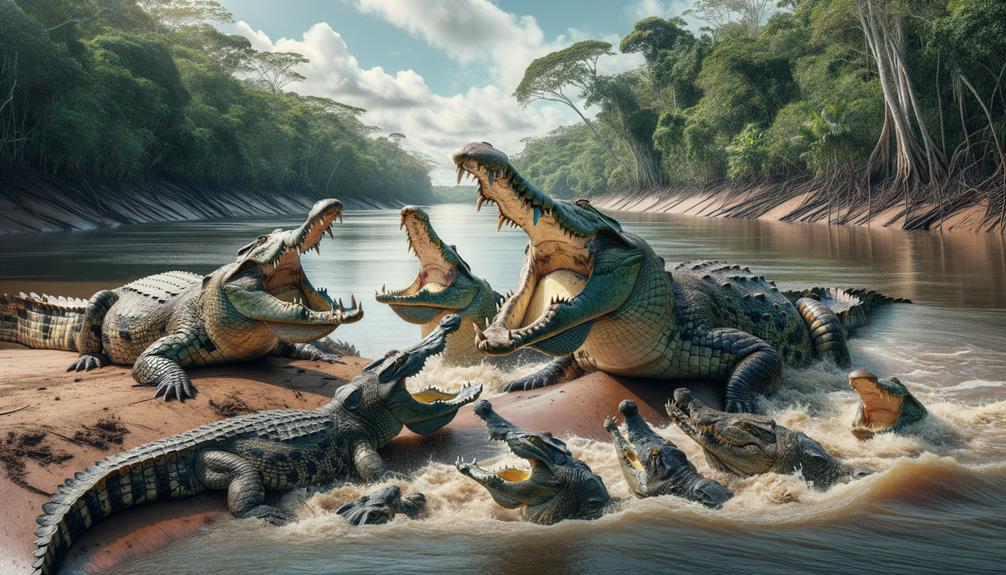
Orinoco crocodiles display a range of fascinating behaviors, from complex social interactions to unique ways of communicating. These traits highlight their adaptability and smarts. One of the most interesting aspects is how they set up pecking orders. These hierarchies control who gets what resources and who mates with whom, keeping things organized in their groups.
These crocs also show impressive teamwork when hunting. They often work together to chase fish into shallow waters, showing a level of cooperation you don't often see in reptiles. Their scaly armor isn't just for protection; it helps them manage their body heat. They can soak up sun or cool off in water to stay at just the right temperature.
When it comes to talking to each other, Orinoco crocodiles use various sounds. They bellow, slap their heads on the water, and thrash their tails. They also use their strong, musky smell to interact. Their keen senses of smell, sight, and hearing help them navigate their world. With eyes set close together, they have good depth perception – crucial for hunting and socializing. All these behaviors show how well-suited these crocs are to their environment.
Diet and Feeding
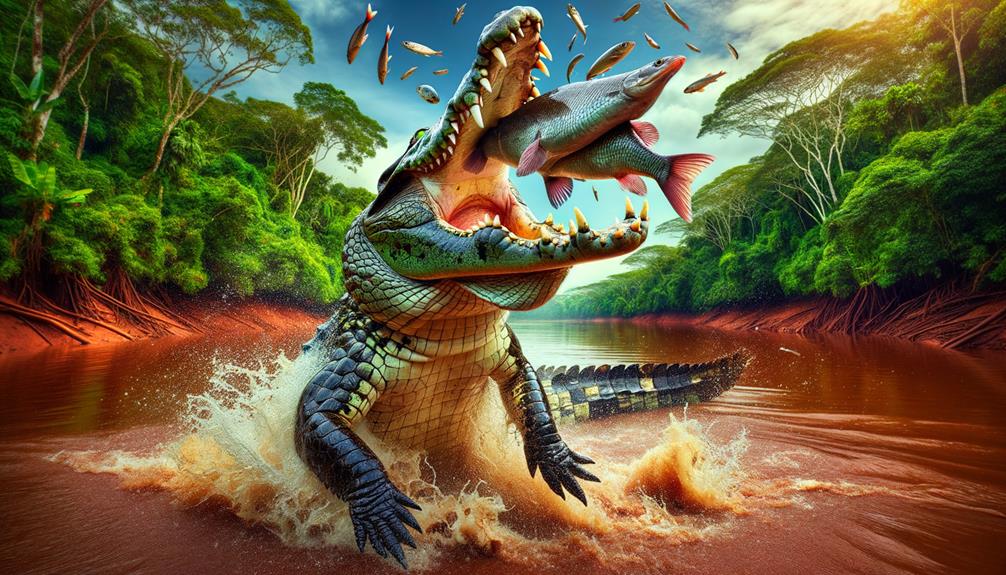
The Orinoco crocodile's diet and hunting habits are truly remarkable. As top predators in their ecosystem, these reptiles have a varied menu. Adult crocs typically go after bigger game like large birds, fish, capybaras, and small mammals. The younger ones, still growing into their predatory role, stick to smaller fare such as insects and snails. What's particularly impressive is their hunting strategy. These crocodiles are masters of the wait-and-strike approach. They'll lie motionless in the water, barely visible, then suddenly lunge at their prey with incredible speed. This method showcases their patience and adaptability in securing food. It's a testament to their evolution as efficient hunters in their South American habitats.
Typical Prey Items
Orinoco crocodiles show a remarkable range in their diet, chowing down on big fish, birds, and smaller critters like capybaras. The young ones mostly go for crabs, snails, bugs, and little fish. As top predators, these crocs rely on sneaky hunting tactics to get their grub. Fish make up the bulk of their meals, with birds and small mammals rounding things out.
These crafty hunters take what they can get, based on what's around. Their varied menu ensures they're getting all the nutrients they need to thrive in the wild.
Let's break down what's typically on their plate:
| Prey Type | Example |
|---|---|
| Large Fish | Catfish, Piranhas |
| Birds | Herons, Egrets |
| Small Mammals | Capybaras, Rodents |
| Invertebrates | Crabs, Snails |
The Orinoco crocodile's knack for switching up its diet based on what's available shows how adaptable these hunters are. Their diverse eating habits not only prove how flexible they can be but also cement their spot at the top of the food chain. By munching on a wide variety of creatures, they keep their ecosystem in check, playing a crucial role in the natural world.
Hunting Techniques
Orinoco crocodiles are master hunters, using stealth and patience to catch their prey. These big reptiles excel at ambush tactics, gliding silently through the water and lurking just below the surface until the perfect moment to attack. This strategy works well for nabbing all sorts of animals, from fish and birds to small mammals like capybaras.
Their eating habits are just as interesting. These crocs can go without food for weeks if needed, which helps them survive when their river home changes. Young ones, still learning the ropes, go after smaller prey such as crabs, snails, bugs, and tiny fish. This diet gives them the nutrients they need and lets them practice the sneak-attack moves they'll use as grown-ups.
The ability of Orinoco crocodiles to stay hidden until they strike makes them tough predators. When they lunge, it's quick and deadly – a testament to how they've adapted over time to be top-notch hunters. Looking at how they hunt shows us a bit about the complex web of life in their ecosystem.
Reproduction
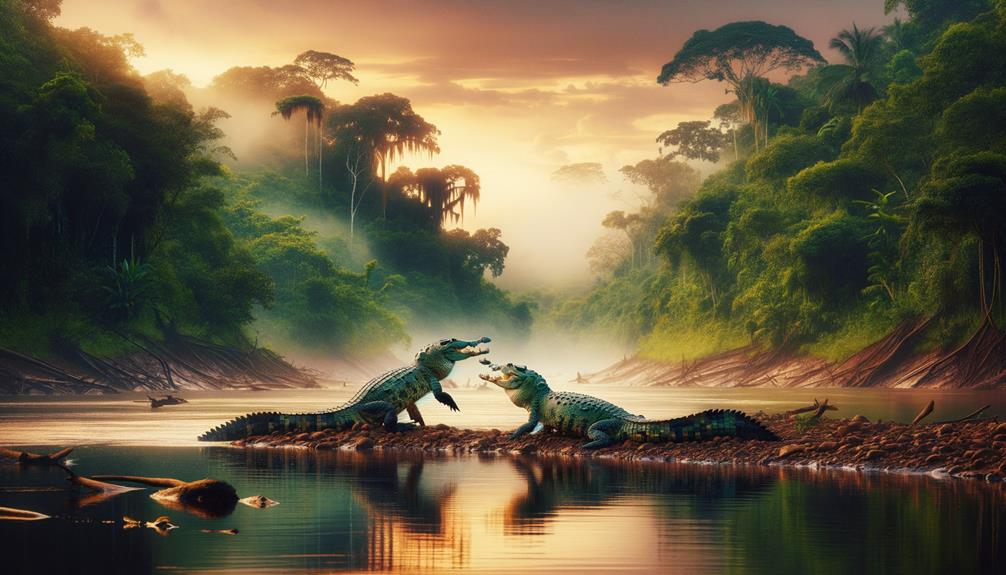
The Orinoco crocodile's mating season starts with a bang in January and February. Males bellow loudly and females build nests on sandy riverbanks. It's quite a show, highlighting nature's raw power. After mating, females lay 15 to 70 eggs in their carefully crafted nests. The eggs incubate for 70 to 90 days, with nest temperature determining the sex of the babies.
These reptiles feast on fish, mammals, and birds to fuel up for the breeding season. Mothers are fiercely protective, guarding their nests from predators. Once the eggs hatch, they continue to care for their young for up to three years, helping them navigate the dangerous waters of their river home.
The mating rituals of Orinoco crocodiles go beyond simple reproduction. It's a complex interplay of sound and strength, all happening along the riverbanks they inhabit. This intricate process ensures the species' survival, showcasing the fragile ecosystem of the Orinoco River.
Conservation Efforts

Biologists are working hard to save the Orinoco crocodile, a species on the brink of extinction. Their efforts include breeding programs and protecting the crocodile's natural habitat. In Colombia and Venezuela, special centers are set up to increase the number of these impressive reptiles. By raising young crocodiles in safe environments, scientists hope to boost their chances of survival before releasing them into the wild.
Putting these crocodiles back into their natural homes is key to increasing their numbers. While international trade bans offer some protection, the Orinoco crocodile still faces dangers from illegal hunting, loss of habitat, and pollution. Conservation teams are tackling these problems head-on. They've stepped up patrols and community education to reduce poaching. They're also setting aside protected areas along the Orinoco River to give these animals safe places to live.
Keeping the water clean is another big part of the plan. Scientists regularly check water quality and work to reduce factory waste that harms the river. They also keep a close eye on the crocodiles they've released, to see how well they're doing and make changes if needed. By working on all these fronts at once, the goal is to ensure the Orinoco crocodile doesn't disappear from our world.
Frequently Asked Questions
How Many Orinoco Crocodiles Are Left?
Current estimates suggest the wild population of Orinoco crocodiles sits between 250 and 1,500 individuals. Conservationists are working hard to protect these impressive reptiles through various programs, including breeding in captivity and releasing them back into their natural habitats. Despite these efforts, the species still faces significant challenges. Illegal hunting, destruction of their living spaces, and human activities continue to pose serious threats to their survival. The road to recovery for these ancient creatures remains long and difficult, highlighting the ongoing need for robust conservation strategies and public awareness.
How Big Is the Orinoco Crocodile?
Today's Orinoco crocodiles can grow up to 16 feet long, though in the past, they reached impressive lengths of 22 feet. These massive reptiles, sporting long, narrow snouts and bodies covered in scutes, rank among the largest in the Americas. Their size and distinctive features make them a standout species in the region's diverse ecosystem. Despite their intimidating presence, these ancient creatures face numerous challenges in their native habitats, highlighting the ongoing need for conservation efforts to protect these remarkable animals for future generations.
What Is the Difference Between an American Crocodile and an Orinoco Crocodile?
American crocodiles stand out from their Orinoco cousins in a few key ways. Their snouts are wider, they're generally smaller, and they make different sounds. Orinoco crocs have a distinctive feature – six scales on their necks. While American crocodiles aren't at risk, Orinoco crocodiles face a tough battle for survival, with their numbers critically low. These differences help scientists and wildlife enthusiasts tell these two species apart in the field.
Why Are Orinoco Crocodiles Important?
Orinoco crocodiles play a key role in their ecosystems. As top predators, they help keep other animal populations in check, which is crucial for maintaining a healthy balance in freshwater habitats. These impressive reptiles also contribute to the overall biodiversity of their environment.
Protecting Orinoco crocodiles isn't just about saving one species. It's about preserving genetic diversity, which is vital for the long-term health of ecosystems. Their presence affects everything from water quality to the well-being of other animals that share their habitat.
Conservation efforts for these crocodiles have far-reaching effects. By safeguarding their environment, we're also protecting countless other species that depend on the same waterways. It's a prime example of how focusing on one keystone species can benefit an entire ecosystem.


